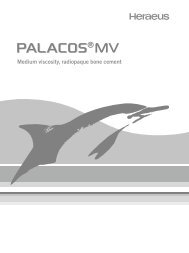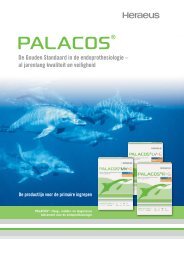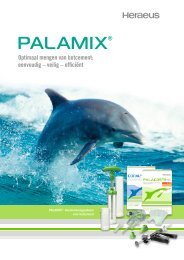griego - Heraeus Medical: Bone Cement
griego - Heraeus Medical: Bone Cement
griego - Heraeus Medical: Bone Cement
Create successful ePaper yourself
Turn your PDF publications into a flip-book with our unique Google optimized e-Paper software.
using it for the first time. Detailed knowledge is necessary<br />
even if mixing systems and syringes are being used for<br />
application of the cement.<br />
The monomer liquid is highly volatile and flammable so<br />
special precautions should be taken, particularly when<br />
using in the operating theatre. The monomer is also a<br />
strong lipid solvent and should not come into direct<br />
contact with the body.<br />
When handling the monomer or the prepared cement<br />
PALACOS ® R+G gloves must be worn which provide the<br />
necessary protection against penetration of the skin by the<br />
monomer methyl methacrylate.<br />
Gloves made of PVP (three-ply polyethylene, ethylene<br />
vinyl alcohol copolymer, polyethylene) and Viton ® /butyl<br />
gloves have proved to provide good protection over a<br />
lengthy period. For safety’s sake it is recommended that<br />
two pairs of gloves be worn over one another, e.g. one<br />
polyethylene surgical glove over an inner pair of standard<br />
latex surgical gloves.<br />
The use of latex or polystyrene-butadiene gloves on their<br />
own is inadequate. Please make enquiries with your<br />
supplier to establish which gloves are suitable for such an<br />
application.<br />
The monomer vapours can irritate respiratory passages<br />
and eyes and possibly cause damage to the liver. Skin irritations<br />
have been described which are due to contact with<br />
the monomer.<br />
Manufacturers of soft contact lenses recommend<br />
removing the lenses in the presence of damaging or irritant<br />
vapours. Since soft contact lenses are permeable to<br />
liquids and gases, they should not be worn in the operating<br />
theatre if methyl methacrylate is being used.<br />
Use on the patient<br />
Blood pressure, pulse and breathing must be monitored<br />
carefully during and directly after introduction of the bone<br />
cement. Any significant change in these vital signs must<br />
be eliminated without delay by taking appropriate action.<br />
When using PALACOS ® R+G the prepared bone should be<br />
carefully cleaned, aspirated and dried just before the bone<br />
cement is placed.<br />
Incompatibilities<br />
Aqueous solutions (e.g. ones containing antibiotics) must<br />
not be added to the bone cement because they have a<br />
considerable detrimental effect on the physical and<br />
mechanical properties of the cement.<br />
Amount required<br />
After mixing the cement powder with the monomer liquid,<br />
a fast-curing ductile dough develops which is introduced<br />
to bone cavities for anchorage and/or filling purposes.<br />
PALACOS ® R+G is coloured green in order to make the<br />
cement clearly visible in the surgical field.<br />
A dose is prepared by mixing the entire contents of the<br />
bag of cement powder with all the monomer liquid of an<br />
ampoule. The quantity of cement dough required depends<br />
9<br />
on the specific surgical intervention and on the technique<br />
being used.<br />
At least one additional dose of PALACOS ® R+G should be<br />
available before commencing the operation.<br />
Preparation<br />
Preparation:<br />
Before opening the non-sterile aluminium protective pouch<br />
(see above) move the contents down (1 poly ethylene-paper<br />
bag) by shaking or tapping in order to ensure that when the<br />
bag is cut open at the top the content is not damaged.<br />
The polyethylene-paper bag and the ampoule may only be<br />
opened under sterile conditions. For this purpose the sterile<br />
components (inner PE-paper bag and glass ampoule) are<br />
sterile when they are delivered.<br />
Opening under sterile conditions:<br />
Open the outer PE-paper bag at the special point under<br />
sterile conditions so that the inner PE-paper bag remains<br />
sterile when it is removed. Also open the blister pack at<br />
the special point under sterile conditions so that the glass<br />
ampoule remains sterile when it is removed.<br />
Before opening the inner PE-paper bag, move the<br />
contents down by shaking or tapping in order to ensure<br />
that when the bag is cut open at the top no powder is lost.<br />
To make it easier to open the glass ampoule the latter is<br />
provided with a predetermined breaking point at the transition<br />
to the head of the ampoule.<br />
The 10ml- and 20ml- ampoule is provided with a snapping-off<br />
device (tube) in order to facilitate the opening<br />
procedure. If this is the case, take hold of the fitted snapping-off<br />
device instead of the ampoule head and break off<br />
the ampoule head over it. When the ampoule head has<br />
snapped off, it remains inside the tube.<br />
Mixing the components:<br />
Component mixing can be performed with a vacuum<br />
mixing system or by hand.<br />
The mixing times, waiting times, working times and curing<br />
times of PALACOS ® R+G can be seen by referring to the<br />
diagrams on the following page. Please note that these are<br />
stated for guidance only because working time and curing<br />
time depend on temperature, mixing and humidity, whereby<br />
the direct ambient temperatures are important, e.g. of<br />
cement powder, mixing system, bench and hands. A high<br />
temperature accelerates the waiting, working and curing<br />
times.<br />
Preparation with a vacuum mixing system<br />
In order to obtain a bone cement with a reduced number<br />
of air inclusions, the liquid and the powder are mixed in<br />
a vacuum. For this purpose an airtight mixing system<br />
has to be used, ensuring that a sufficient vacuum builds<br />
up in the mixing vessel quickly (pressure approx.<br />
200 mbar absolute). It is recommended that the cement<br />
components be precooled at 4–7°C for at least 24 hours.<br />
The cement components should only be removed from<br />
EN






